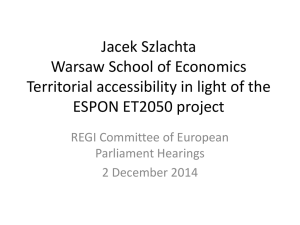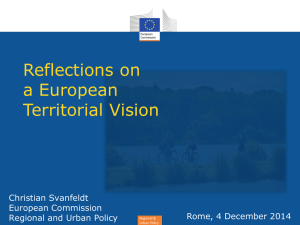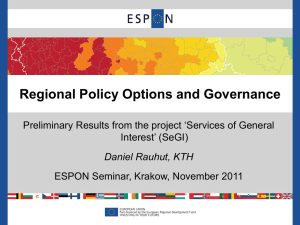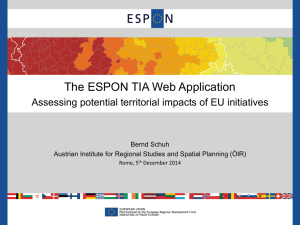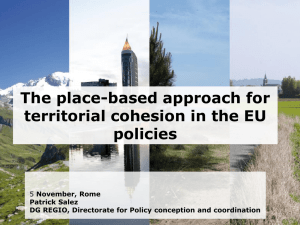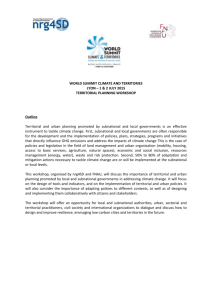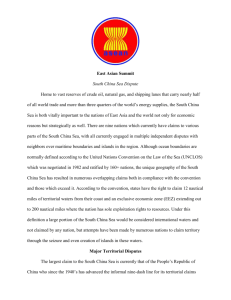here in English
advertisement
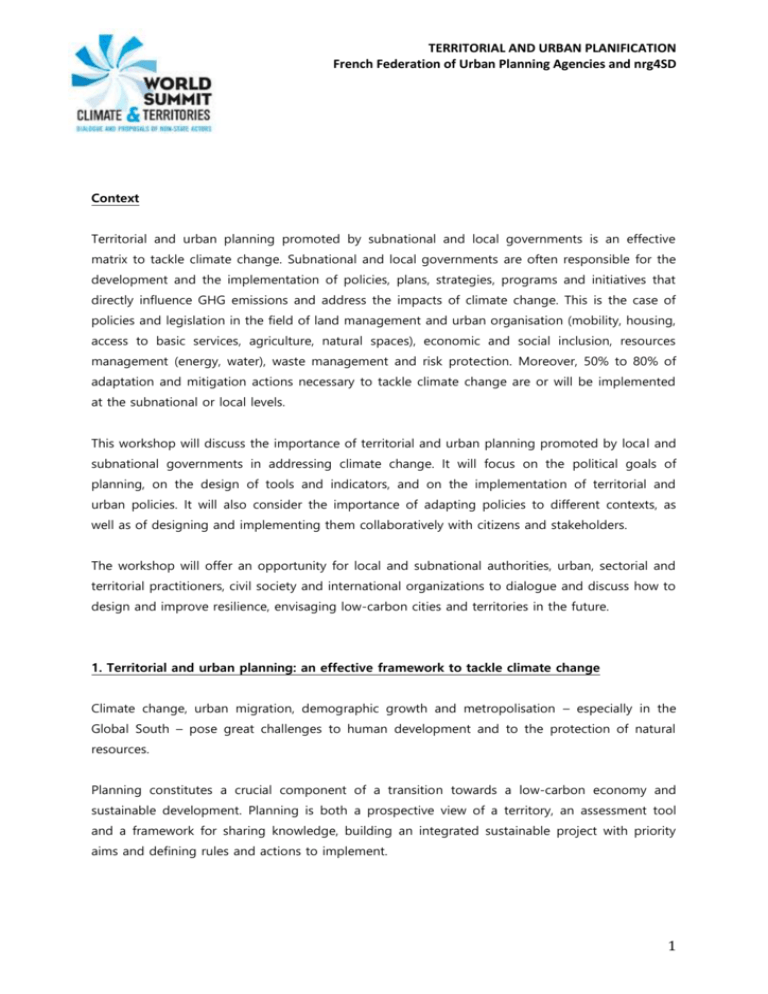
TERRITORIAL AND URBAN PLANIFICATION French Federation of Urban Planning Agencies and nrg4SD Context Territorial and urban planning promoted by subnational and local governments is an effective matrix to tackle climate change. Subnational and local governments are often responsible for the development and the implementation of policies, plans, strategies, programs and initiatives that directly influence GHG emissions and address the impacts of climate change. This is the case of policies and legislation in the field of land management and urban organisation (mobility, housing, access to basic services, agriculture, natural spaces), economic and social inclusion, resources management (energy, water), waste management and risk protection. Moreover, 50% to 80% of adaptation and mitigation actions necessary to tackle climate change are or will be implemented at the subnational or local levels. This workshop will discuss the importance of territorial and urban planning promoted by local and subnational governments in addressing climate change. It will focus on the political goals of planning, on the design of tools and indicators, and on the implementation of territorial and urban policies. It will also consider the importance of adapting policies to different contexts, as well as of designing and implementing them collaboratively with citizens and stakeholders. The workshop will offer an opportunity for local and subnational authorities, urban, sectorial and territorial practitioners, civil society and international organizations to dialogue and discuss how to design and improve resilience, envisaging low-carbon cities and territories in the future. 1. Territorial and urban planning: an effective framework to tackle climate change Climate change, urban migration, demographic growth and metropolisation – especially in the Global South – pose great challenges to human development and to the protection of natural resources. Planning constitutes a crucial component of a transition towards a low-carbon economy and sustainable development. Planning is both a prospective view of a territory, an assessment tool and a framework for sharing knowledge, building an integrated sustainable project with priority aims and defining rules and actions to implement. 1 TERRITORIAL AND URBAN PLANIFICATION French Federation of Urban Planning Agencies and nrg4SD Through planning, governments can identify the most important sources of GHG emissions and the most vulnerable areas and communities affected by climate change. With this, governments can develop useful quantification and qualification tools to measure GHG emissions and promote risk assessment. Planning for climate change is a means to put in place the principle of ‘common good’ within environmental goals that are socially and economically equitable. Through planning, it is possible to: - Reduce consumption and increase efficiency in the use of natural resources, particularly water and energy - Promote self-supply solutions depending on the proximity of resources - Promote renewable energies, linking urban development, energy networks, production and deployment - Promote sustainable growth through reduced land-consumption, urban-sprawl and cartraffic, especially by inciting urban regeneration and public transport networks and quality public areas, able to facilitate sustainable mobility, guide urban morphology and housing production - Stimulate a circular economy, developing cooperation between urban and rural areas, the eco-conception in urban design, building and urban services such as waste collect and recycling - Increase resilience, protecting natural and agriculture areas, promote bioclimatic conception to absorb the temperature rise and limit heat waves, protect water resources and costal areas, developing adaptation plans to prevent and ensure the appropriate response of the population to vector-borne diseases, resources scarcity and extreme weather episodes. - Promote civil society engagement, raising awareness and environmental education as key elements for efficient mitigation and adaptation measures. Therefore, territorial and urban planning offers an opportunity to build an integrated approach, strengthening urban-rural interconnectivity in a sustainable way, adapted to different scales and contexts. Ultimately, planning helps limit GHG emissions, as well as protecting natural resources. It also strengthens regional and local resilience to climate change, natural and human risks. Moreover, regional and urban planning can help empowering relevant stakeholders. Overcoming obstacles 2 TERRITORIAL AND URBAN PLANIFICATION French Federation of Urban Planning Agencies and nrg4SD Planning strategies often lack cross-sectorial and thematic aspects, and rarely consider the pressure on available resources. Regional and local planning policies also suffer from weak definition of responsibilities in the framework of developing, financing, implementing and monitoring mitigation and adaptation measures. It is also clear that major methodological problems still affect the appropriate assessment and monitoring of GHG emissions, as well as the assessment of the impact of climate change on territories and economic activities at subnational and local levels. Improved quantification and qualification tools and ways of assessing alternatives are necessary to enhance climate projection models that reduce risk and uncertainty. It is, therefore, important to further develop the design of a system of indicators that allows for the continuous improvement of measures taken. Particularly regarding the indicators architecture for monitoring GHG emissions and climate change impacts, it is important to emphasize the absence of common metrics and methodologies among multiple reporting platforms, which prevents comparability, benchmarking and collaboration. Moreover, the lack of disaggregated data by geographical location and sectors compromises an appropriate diagnosis and tailored-cut action for each specific area. Moreover, regional and local governments require support and funding to design and implement territorial planning that promotes climate mitigation and adaptation measures. Shared responsibility instruments and funds for financing climate policies will be instrumental in making future decisions. This is particularly the case of cities and regions in the Global South facing a strong urban development. Lastly, subnational and local governments must define mitigation and adaptation measures with participation of relevant stakeholders and citizens, notably youth and women. This would help to develop a set of indicators to measure the effectiveness of planning measures. Territorial and urban planning constitutes an integrated and cross-sectorial approach, which can also focus on climate and energy objectives, for example, through climate plans. These obstacles should be overcome by an integrated territorial planning, where natural, rural, rural-urban and urban areas are well interconnected, involving all the competent actors, institutions and government departments, in order to ensure and safeguard natural resources and services. It is also crucial to attain cohesion in the actions taken at all levels, exploring synergies for stronger and complementary efforts among governments and stakeholders. Therefore, a new 3 TERRITORIAL AND URBAN PLANIFICATION French Federation of Urban Planning Agencies and nrg4SD and improved governance model is necessary as fundamental step to promote multilevel and multi-stakeholder coordination. 2. Good practices on urban and regional planning There are a number of examples of good-practices on regional and urban planning, which are promoting climate change and adaptation. Some examples are presented below. - Addis Ababa, Ethiopia: transport challenges in a booming city Addis Ababa, the capital of Ethiopia, is a 4.6 million inhabitants city. Coordinate mass transit network and urban development is a main challenge. In 2003, transportation was chosen as an axis to plan the city development. It was decided to transform the city into a polycentric metropolis to reduce the congestion. A mixed-use land planning and the protection and development of green spaces to provide quality of life and to reduce natural resources consumption were used. A Transport System Plan was designed with a climate change adaptation policy. Public mass transport system was developed with the introduction of Bus Rapid Transit and upgrading existent bus services; recommendations for pedestrian facilities were also prescribed. - Ahmedabad, India: inclusion and adaption to climate change through transport planning Ahmedabad is a city of 5.8 million inhabitants. At first a political capital, the city declined in the 1970’s. Underinvestment in infrastructure and services led to less transport structures and so, to high levels of congestion and reduction in air quality. A Bus Rapid Transit System (BRTS) was designed to attract latent transit demand, avoid urban sprawl and improve air quality. In 2005, the Accessible Ahmedabad framework redesigned the city structure and transport systems towards accessibility, efficient mobility and lower carbon emissions. The aim was to improve public transport, to reduce the need to travel by car or two-wheels. 217 km of BRT corridors were designed. 26% of two-wheeler users have shifted to BRTS and 200 000 vehicle kilometres are saved per day. It has enhanced environmental quality but also social inclusiveness. Indeed, transportations are equally used in low-income neighbourhoods than in higher-income ones. - Catalonia, Spain: Mobilty plan of the metropolitan region of Barcelona The Mobility Plan 2013-2018 of the Metropolitan Region of Barcelona establishes measures to be taken in the coming years on the field of the mobility of people and goods. The Plan identifies 10 priorities objectives that are specified in 9 areas of action and 360 measures. The budget estimated of all activities is 52 million €. The technical evaluation of the plan includes an analysis of GHG emission reductions that will be achieved with the implementation of mitigation measures 4 TERRITORIAL AND URBAN PLANIFICATION French Federation of Urban Planning Agencies and nrg4SD in accordance with the 2020 EU Climate and Energy Package. It is expected to reduce 1.5Milions Tons of CO2/year. - Basque Country, Spain: managing the territorial land-use planning at the regional level The Basque Territorial Strategy was developed through a cross-sectorial perspective and in a collaborative approach with all relevant territorial public authorities. The Strategy is defined by three instruments: (1) “Territorial Guidelines”; (2) cross-sectorial “Partial Territorial Plans”, one for each of the 15 territorial areas; and (3) “Sectorial Territorial Plans” to deal with the territorial perspective of a particular issues, such as rivers, coastline, railways, rural areas and public housing. The Basque Territorial Strategy also applies to local urban planning; for instance, it is binding for local authorities when calculating the number of new housing foreseen by the urban plan. The Strategy is about to be revised; the revision will be based on a wide participatory process and it will pay a special attention to green infrastructures, ecosystem services and climate change. - Brest Metropole, France: Local Urban Plan, integrated planning dealing with a climate ambition Brest Metropole has designed a global Local Urban Plan that includes a housing development plan, a mobility plan, and a territorial climate and energy plan. City representatives, civil society and local experts devised this metropolitan planning. Introducing a territorial climate and energy plan in a local urban plan is a new and ambitious idea. Every public policy designed from that plan has energy aims; for example, energy consumption objectives for housing projects to avoid energy waste. The global objective is to promote a compact city, with a good system of public transportation. Public areas are designed considering safety for bicycles and pedestrians. This integrated approach of land-use, housing, transportation and energy plans, leads to an integrated planning focused on adaptation to climate change. - Melbourne, Australia: “‘nature sensitive”’ urban design and planning Melbourne has experienced extreme climate episodes lately, with low rainfalls, main heat events and a rising temperatures. In the meantime, the city’s urban rainforest was seriously declining due to drought and severe water restrictions. A new approach to urban planning through an ecosystem-based climate adaptation program was developed in Melbourne to enhance nature within the urban setting. In 2010, the Urban Landscapes Adaptation Program was launched to reduce drought vulnerability and to cool the city by 4°C. Two main actions were developed: the Open Space Strategy, to increase green space by 7.6% and the Urban Forest Strategy, to double the City’s tree canopy to 40%. Program is in action and is already showing results. A programme to develop public awareness about impacts of climate change completes it. - Medellin, Colombia: social planning 5 TERRITORIAL AND URBAN PLANIFICATION French Federation of Urban Planning Agencies and nrg4SD Medellin is the 2nd largest city in Colombia with 2.4 million inhabitants. Its urban development combined a population growth, mainly due to rural exodus, and urban sprawl. Those two processes led to fragmentation of the territory and exclusion. Since 2003, social urbanism became the new territorial policy. The Integral Urban Project set innovative and adapted development projects to urge mobility for inhabitants and improved transportation systems, to create social diversity. Physical transformations in the urban fringes made public places safer and more accessible connected every district to the city centre and considered environmental factors as a way to reintegrate those scattered areas to the city. 3. Recommendations and commitments to promote the role of territorial planning in addressing climate change In order to reinforce and develop the existing dynamics of using territorial planning to address climate change, we propose the following actions: 3.1. Territorial planning as a governance process Territorial planning should be considered as a governance process that: - Builds common political aims - Provides legal frameworks - Defines policies and projects - Promotes assessments and monitoring - Promotes involvement and collaboration of citizens, the private sector and wide stakeholder through participatory instances and mechanisms through partnerships between public institutions, private actors and the population (4Ps), strengthening democracy. 3.2. Territorial planning as a process with multilevel commitments and action In order to address climate change, territorial planning commitments must involve multilevel institutions and action so that: 6 TERRITORIAL AND URBAN PLANIFICATION French Federation of Urban Planning Agencies and nrg4SD - States/National governments establish legislative frameworks, organize decentralised competences, and provide financial and fiscal resources that guarantee further powers for regional and local authorities to experiment and implement policies - Regional governments implement territorial policies and transition actions - Urban and local governments implement an integrated approach of urban development and resources management, notably to put in place climate plans, and also to climateproof territorial plans 3.3. Supporting and financing regional and local governments initiatives to address climate change through territorial planning Intergovernmental organisations and national governments should stimulate and support territorial planning which address climate change adaptation and mitigation measures. We suggest to - Mobilize the “UN Green Fund” to help financing urban and territorial integrated planning focused on protection of natural resources and GHG emissions - Through the Habitat III process, implement the UN habitat guidelines for decentralisation, access to basic services and urban and territorial planning, and develop actions for “climate plans” and “mobility and transport management”; promote guidelines for the implementation of climate action plans and mobility management - Support the development and the dissemination of reference frameworks, methods and monitoring tools within a set of environmental, economic and social criteria - Contribute for the development of a common agenda for the climate and promote networks and collaborative platforms that promote information sharing and capitalize experiences (e.g. Covenant of Mayors, Urbact, Carbon Neutral Municipalities Project in Europe, Metropolis at worldwide scale) - Support capacity-building tools that promote territorial knowledge and implement planning processes such as urban planning agencies, data platforms, skills for professionals, capacity building of communities 7 TERRITORIAL AND URBAN PLANIFICATION French Federation of Urban Planning Agencies and nrg4SD 3.4. Territorial planning facilitating energy supply, energy demand and adaptation measures Planning interventions are critical mechanisms to promoted energy supply, energy demand and adaptation measures. Territorial planning should: - Regulate energy supply in both large and small scale renewable energy facilities - Reduce car travel. Planning’s proactive intervention must steer the location, mix and accessibility of development, which in the long term has substantial implications for the level of demand on transport, modal choice and journey distances. - Increase the energy efficiency of the built environment. Planning’s regulatory interventions can fill the gap left by building regulations to ensure higher environmental standards in new-built as well as existing stock. Planning can also play a proactive role in the framework of urban regeneration schemes, for instance by promoting the design of eco-districts. - Promote adaptation of the built environment to climate change impacts. Planning should consider the location of new developments away from risk areas (flood risks and costal erosion), the design and layout of buildings and urban areas, which are resilient particularly to heat waves, and the promotion of sustainable water management in new developments. 3.5. Quantitative objectives Urban and territorial planning is an integrated policy that depends on local and regional contexts. Therefore, quantitative objectives have to be defined and take into account State commitments and the specificities of the different scales involved in territorial planning. There is a need to guarantee accountability and transparency of policies and laws. 4. Amendments to the COP 21 text of negotiation Many cities and regions are strongly committed to mitigating GHG emissions. Their proposals and quantitative objectives are expected to save more 1 giga-tons of GHG emissions until 2020. This is the starting point for the commitments that will be made by member-states at COP21. Recalling, para.7 of Dec.1/CP16, adopted at COP16 in Cancun in 2010, that recognizes local and 8 TERRITORIAL AND URBAN PLANIFICATION French Federation of Urban Planning Agencies and nrg4SD subnational governments as “governmental stakeholders”, Further recalling, para.5b of Dec.1/CP19, adopted at COP19 in Warsaw in 2013, that recognizes role of cities and subnational authorities in raising pre2020 ambition, Parties to the UNFCCC should, as appropriate, seek to engage their local and subnational governments, to achieve the objectives of the Convention and the implementation of the Paris2015 Outcomes by - Policy tools. - Guidelines and programmes. - Providing technical, financial, institutional assistance and/or guidance, as appropriate, to support their national contributions, plans, commitments and actions, in line with other relevant governance arrangements established by their national Governments. - Providing a national framework setting quantitative objectives at regional and local levels with the appropriate tools to measure reduction. Parties to the UNFCCC should underline that territorial planning is an essential direction to ensure structural reduction of GHG on the long term, designing low carbon infrastructure and service development and shaping the evolution of the economy toward low carbon solutions… Doing so, Parties to the UNFCCC should encourage their local and subnational governments, to include citizens and all stake holders in participatory process, as this participation is key for the richness and robustness of these plans. 9
